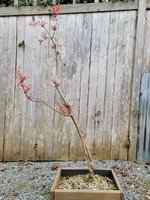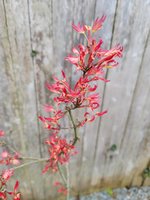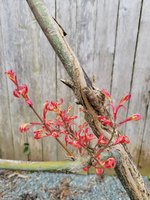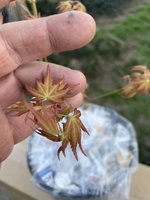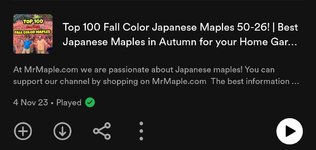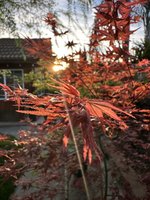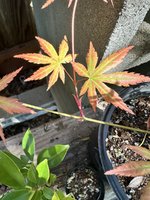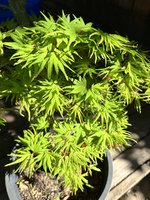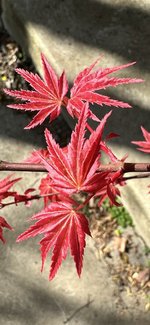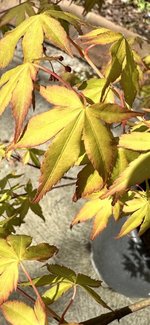You are using an out of date browser. It may not display this or other websites correctly.
You should upgrade or use an alternative browser.
You should upgrade or use an alternative browser.
Show your 2024 maple colors!
- Thread starter 19Mateo83
- Start date
19Mateo83
Masterpiece
The new addition from maples n more nursery. This bonfire JM is 
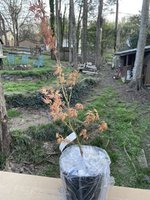
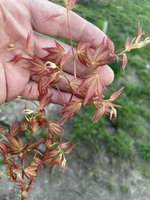
 www.bonsainut.com
www.bonsainut.com


Maples N More nursery unboxing review!
I decided to do add a new maple to my collection this spring. Instead of going to the usual places I decided to roll the dice and order a “bonfire” Japanese maple from Maples N More nursery in Burnsville NC. You all know that I like supporting small businesses and I hadn’t heard anyone mention...
Attachments
Japonicus
Masterpiece
I'm a big fan of Wilsons Pink.
I have one in ground I plan to get a couple of layers from.
Me too! That one is actually a cutting, and I took two air layers last year that rooted very well. It's a strong cultivar for a "dwarf".I'm a big fan of Wilsons Pink.
I have one in ground I plan to get a couple of layers from.
Faisal Ahmad
Mame
No maple here, cannot survive in my place 



Is this just a common misnomer or is there actually another cultivar that is like Wilsons Pink Dwarf, but is larger?Wilsons Pink
Maiden69
Masterpiece
@William N. Valavanis posted on his blog that he gets quite a few arakawa seedlings from his large garden tree that do develop the rough bark including on the roots as his cuttings.Technically not possible…
This year all my JMs lack color, all the foliage so far has been green.
Mikawa seedling
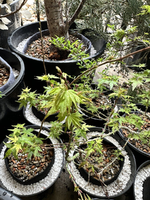
Kotohime
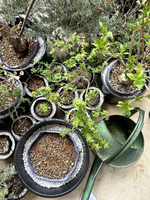
Hubble's Cork
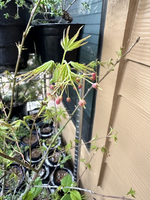
Brian Van Fleet
Pretty Fly for a Bonsai Guy
Correct use of/adherence to the term cultivar is important to the preservation of their specific characteristics. Cork bark doesn’t necessarily mean it is an ’Arakawa’ cultivar. This is a bad example because arakawa loosely means rough bark. But it isn’t possible to have a ‘Koto-hime’ seedling.@William N. Valavanis posted on his blog that he gets quite a few arakawa seedlings from his large garden tree that do develop the rough bark including on the roots as his cuttings.
This year all my JMs lack color, all the foliage so far has been green.
Mikawa seedling
Kotohime
Hubble's Cork
Maiden69
Masterpiece
That makes sense, but wouldn't the arakawa seedlings that show the same traits and characteristics be called an arakawa? I guess the only way to determine if it is the actual cultivar would be by doing a DNA testing, but then again, if the seedlings develop the correct traits how do we know that what we have is the actual cultivar? It could have been a cutting from an arakawa seedling.Correct use of/adherence to the term cultivar is important to the preservation of their specific characteristics. Cork bark doesn’t necessarily mean it is an ’Arakawa’ cultivar. This is a bad example because arakawa loosely means rough bark. But it isn’t possible to have a ‘Koto-hime’ seedling.
This is what MrMaple is doing with the mikawa yatsubusa seedlings, labeling them as suck and specifying that the traits are different from the cultivar.
Wilson's Pink Dwarf is the whole name. I believe some just shorten it in conversation. Apparently some think the tree grows too large to be called a dwarf, but I think small leaves and good vigor are great for bonsai purposes.Is this just a common misnomer or is there actually another cultivar that is like Wilsons Pink Dwarf, but is larger?
Piedmont Bonsai
Mame
you could call it a seedling from arakawa, but not Arakawa.
Some seedling may have rough bark some may not. And if you have a handful of seedlings with the rough bark they all may have completely different leaf color, shape, and size from each other and from Arakawa.
With that being said. I have seen a variance in leaf color and shape in rough bark maples labeled as Arakawa being sold in the US
Some seedling may have rough bark some may not. And if you have a handful of seedlings with the rough bark they all may have completely different leaf color, shape, and size from each other and from Arakawa.
With that being said. I have seen a variance in leaf color and shape in rough bark maples labeled as Arakawa being sold in the US
Brian Van Fleet
Pretty Fly for a Bonsai Guy
Yes, generically arakawa, but not Acer palmatum, ‘Arakawa’.That makes sense, but wouldn't the arakawa seedlings that show the same traits and characteristics be called an arakawa?
Yes, assuming it’s actually mapped.I guess the only way to determine if it is the actual cultivar would be by doing a DNA testing,
We don’t, therefore it’s not a cultivar. Cultivars are propagated as clones: air layer, cutting, grafting, tissue culture from a known cultivar.but then again, if the seedlings develop the correct traits how do we know that what we have is the actual cultivar?
Generically arakawa, not Ap, ‘Arakawa’.It could have been a cutting from an arakawa seedling.
Probably the correct way to handle this.This is what MrMaple is doing with the mikawa yatsubusa seedlings, labeling them as suck and specifying that the traits are different from the cultivar.
I totally agree. However, I wonder if we even know for sure what the exact 'Arakawa' cultivar is any more. It's very possible that enough nurseries have slapped the name on rough bark seedlings for long enough now that it does more generally apply to similar trees, much like has happened with Sango kaku. I also noticed that Meriggioli's book mentions that Arakawa can have varying leaf forms from tree to tree.Correct use of/adherence to the term cultivar is important to the preservation of their specific characteristics. Cork bark doesn’t necessarily mean it is an ’Arakawa’ cultivar. This is a bad example because arakawa loosely means rough bark. But it isn’t possible to have a ‘Koto-hime’ seedling.
NateDyk47
Mame
Seedlings from an 'Arakawa' will have different genetics, even if both parent plants are the 'Arakawa' cultivar. It will share some, possibly many, traits with the parents, but will not be identical. It may even exhibit characteristics that are better than the parents. If your goal is to create a good bonsai or landscape tree, I wouldn't worry too much about whether it's the cultivar or not, just whether it has the traits you desire. If you're trying to run a nursery and sell JMs, you may care more about having an exact genetic copy of popular cultivars for marketing purposes.That makes sense, but wouldn't the arakawa seedlings that show the same traits and characteristics be called an arakawa? I guess the only way to determine if it is the actual cultivar would be by doing a DNA testing, but then again, if the seedlings develop the correct traits how do we know that what we have is the actual cultivar? It could have been a cutting from an arakawa seedling.
This is what MrMaple is doing with the mikawa yatsubusa seedlings, labeling them as suck and specifying that the traits are different from the cultivar.
NateDyk47
Mame
I'm sure this is happening to some extent. I heard on the Mr. Maple podcast recently that they did genetic testing on a bunch of plants being sold as 'Bloodgood' and found 18 unique sets of genetics. This probably happened due to the exact scenario you described. If you really care about getting a particular cultivar, I guess you have to make sure you're getting it from a reliable source.I totally agree. However, I wonder if we even know for sure what the exact 'Arakawa' cultivar is any more. It's very possible that enough nurseries have slapped the name on rough bark seedlings for long enough now that it does more generally apply to similar trees, much like has happened with Sango kaku. I also noticed that Meriggioli's book mentions that Arakawa can have varying leaf forms from tree to tree.
Re: Meriggioli's book - I've only read part of it so far. However, I've heard from others here that his bonsai development explanations are excellent, but his JM horticultural knowledge seems to have some gaps.
Interesting! which episode was that on?I'm sure this is happening to some extent. I heard on the Mr. Maple podcast recently that they did genetic testing on a bunch of plants being sold as 'Bloodgood' and found 18 unique sets of genetics. This probably happened due to the exact scenario you described. If you really care about getting a particular cultivar, I guess you have to make sure you're getting it from a reliable source.
Re: Meriggioli's book - I've only read part of it so far. However, I've heard from others here that his bonsai development explanations are excellent, but his JM horticultural knowledge seems to have some gaps.
Japonicus
Masterpiece
I'm only aware of the cultivar Wilson's Pink known as a dwarf variety.Is this just a common misnomer or is there actually another cultivar that is like Wilsons Pink Dwarf, but is larger?
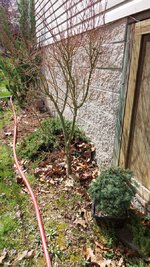
This one hasn't opened up yet.
It is a bit more weather savy than my Katsura. Went in ground 2018 or shortly before probably more like it. Turns green for the Summer. Don't think Fall is anything to write home about, but for detailed Spring display up close it's quite attractive.
Handles full Sun till mid afternoon like a champ then shade the remainder of the day.
Leaves remain quite small as well as short enough internodes. Internodes reduce well with pruning. I'll be sure to post pics as it opens up.
NateDyk47
Mame
19Mateo83
Masterpiece
Another sweet little kiyo hime in all of its glory. This one is still on grafted rootstock but the graft is clean and the roots are nice and radial. Excellent spring colors.
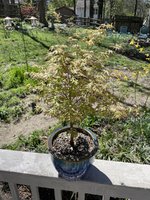
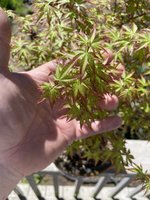
The second one was a discount rack pick up, it is the rootstock that the graft had died on at Home Depot. It has lovely spring color for a green JM
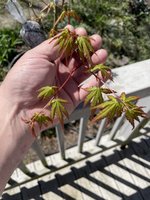


The second one was a discount rack pick up, it is the rootstock that the graft had died on at Home Depot. It has lovely spring color for a green JM

rollwithak
Chumono
Similar threads
- Replies
- 8
- Views
- 236
- Replies
- 1
- Views
- 240
- Replies
- 97
- Views
- 6K
- Replies
- 11
- Views
- 323

